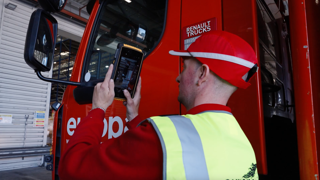By Jim Billings, practice leader at Motor Risk Solutions at QBE Insurance
In the world of transport, haulage and supply chain logistics, traffic incidents impose significant financial and human costs on businesses, with collisions involving driving under the influence (DUI) a persistent challenge.
Technology will play an essential role in 2025 in reducing these risks so fleet operators can better protect their drivers and cargo.
Every year, around 40,000 people in the UK are injured in collisions that involve someone who was driving for work. And in 2022, an estimated 6,800 people were killed or injured when at least one driver was over the drink-drive limit.
Here are four trends set to reshape fleet safety in 2025:
Alcohol interlocks
Excess alcohol contributes to about 25% of all road deaths in Europe. One of the most direct ways to prevent DUI in commercial operations in 2025 will be through alcohol detection systems integrated into vehicles.
Alcohol interlocks are automatic control systems which require a driver to pass an in-car breathalyser test before enabling the ignition to start.
In 2025, alcohol interlocks will become more commonplace in fleet vehicles across Europe.
Advanced detection systems can also connect to a fleet management system, providing real-time alerts to supervisors if a driver fails the test. This feedback allows for rapid intervention, ensuring that potential risks are addressed before they manifest into serious incidents.
For an insurer, installing interlocks directly prevents alcohol-related accidents, saving lives and reducing the risk profile of a fleet.
Driver telematics
Telematics systems gather data points and can report in real-time on vehicle location, driver behaviour, engine diagnostics and vehicle activity.
This data can be analysed, potentially harnessing artificial intelligence to help fleet operators better manage their resources, but also to spot inconsistencies including DUI.
These systems monitor commercial driver behaviours, including speed, braking patterns, and acceleration. Sudden erratic driving patterns, unusual acceleration, or inconsistent speeds can be indicators of DUI.
Telematics systems can check for these issues and flag them for further investigation. For insurers, telematics can provide a detailed real-time risk profile of the fleet, leading to more accurate risk profiling.
In-cab cameras
In-cab camera systems, now often paired with AI monitoring software, can observe a driver’s behaviour in real-time and detect signs of distraction or drowsiness by analysing facial expressions, eye movements, and head positions.
If the system detects behaviour that demonstrates DUI, it can alert both the driver and the fleet operator, allowing for immediate corrective action.
These camera systems often integrate with other safety technologies, such as Automated Lane Keeping and Collision Avoidance Systems, creating multiple layers of protection against DUI.
For insurers, when used correctly, the presence of AI-empowered in-cab cameras not only reduces risk but also provides valuable data in the event of a claim. Similarly, dashboard-cameras provide useful information when settling claims.
Education, training and policy
While technology plays a vital role in preventing DUI, fleet operators must equally look at human factors in 2025 working to create a culture of safety through continuous driver education and training.
Modern simulators and online courses provide a realistic training environment to help potential or current drivers better understand the risks of DUI.
The Health & Safety at Work Act, 1974, says: “It shall be the duty of every employer to ensure, so far as is reasonably practicable, the health, safety and welfare at work of all employees.”
All fleet operators must maintain a company policy that puts employee safety first. Safety policies must be look to the future, encouraging employees to take steps to improve their safety. They should not be open to interpretation and employees must be consulted in their drafting. They must be kept up to date in line with new technology.
Driving under the influence is inherently dangerous and fleet operators are under constant pressure to improve safety to protect their drivers and their business.
In 2025, modern technologies can help mitigate risk but must be adopted carefully, with company policy updated and drivers educated in their correct use. These technologies can also offer a pathway to more accurate risk profiles and mitigation tools.
By working together, technology providers, fleet operators, and insurers can create safer roads for everyone.




















Login to comment
Comments
No comments have been made yet.